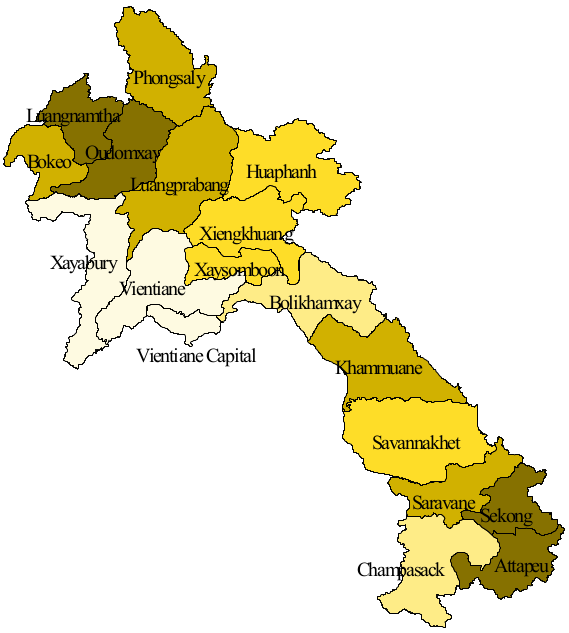Laos Coffee brief History of Coffee cultivation in Laos
Coffee cultivation in Laos has a history of about 100 years. It was originally introduced by the French.
Coffee cultivation can be divided into four stages:
From 1920 to 1940, the French introduced coffee and operated coffee farms, and local farmers gradually began to grow coffee.
From 1940 to 1975, affected by external factors such as war and agricultural disasters, farmers mostly abandoned coffee or switched to Robusta.
From 1975 to 1990, develop state-owned coffee farms and pursue high production.
In 1990, the farm returned to private ownership.
Coffee variety
Around 1920, French settlers began to grow coffee, mainly Arabica iron pickup and bourbon, on the Brawan plateau in southern Laos.
From 1940 to 1990, under the influence of external environment, such as war, agricultural disasters (mainly frost and leaf rust) and national policy, coffee varieties were gradually replaced by Robota species with stronger disease resistance and higher yield, and there were also a few Liberika species.
After 1990, the Arabica species began to receive renewed attention.
At present, the output of Robusta is still in the majority.
Traditional coffee producing areas: Bolaven Plateau, Brawan Plateau
Bolaven Plateau, Brawan Plateau, the name comes from the region's most populous ethnic group "the Laven", which originally means "the home of the Lavan people". It is located between the Annan Mountains, the border between Laos and Vietnam to the east, and the Mekong River to the west at an altitude of about 1000 to 1350 meters (3300 to 4430 feet).
The Brawan Plateau has the longest history of coffee cultivation in Laos, and it is also the region with the widest planting area and the largest coffee production. Among them, the three areas covered by the plateau (namely, Basong Paksong in Basong province, Thateng in Saravan province and Laongam in Sekong province) account for 95 per cent of the total coffee production in Laos. The coffee planting area in the three regions is about 70000ha.
In addition to the three areas mentioned above, coffee is also produced in other areas of the Brawan Plateau.
In addition, coffee is also grown in the northern provinces on a smaller scale.

Important Notice :
前街咖啡 FrontStreet Coffee has moved to new addredd:
FrontStreet Coffee Address: 315,Donghua East Road,GuangZhou
Tel:020 38364473
- Prev
The difference between mocha beans, mocha pot and mocha coffee, a brief introduction to Yemen mocha coffee
For professional baristas, please pay attention to the difference between mocha beans, mocha pots and mocha coffee in the coffee workshop (Wechat official account cafe_style). A brief introduction to mocha coffee in Yemen more than 1500 years ago, coffee trees were introduced to Yemen on the other side of the Red Sea, thus starting a journey of coffee beans around the world. Yemeni coffee is exported from the port of Mocha (now silted and abandoned) to all parts of the world.
- Next

Coffee and health, will drinking coffee get angry? What kind of person is not suitable for coffee?
Some friends like coffee very much, but they are afraid that they will get angry if they drink it often. Will you get angry if you drink coffee? In traditional Chinese medicine, fever has a deeper meaning, that is, some broad symptoms of fever, such as stomach fire can have stomachache, dry stool, bad breath, lung fire can have symptoms such as hemoptysis, cough, yellow phlegm and so on. Liver fire will have some irritability, insomnia, women will have breast pain, heart fire.
Related
- How did the Salvadoran coffee industry develop in Central America?
- What exactly does the golden cup extraction of coffee mean?
- The Origin of Coffee flower
- [2023 Starbucks World Earth Day] there are more meaningful things besides free Starbucks coffee!
- What kind of coffee is there in Spain? 9 Flavors of Spanish Coffee
- Aromatic African coffee| Kenya's coffee culture and historical production area
- Liberica Coffee Bean knowledge: the characteristics of Liberian Coffee beans of the three original species of Coffee beans
- The origin and formula of Spanish latte introduces the taste characteristics of Bombon coffee in Valencia, Spain.
- How to adjust the solution of over-extracted coffee
- What is the tasting period of coffee beans? What is the period of coffee and beans? How should coffee wake up and raise beans?

